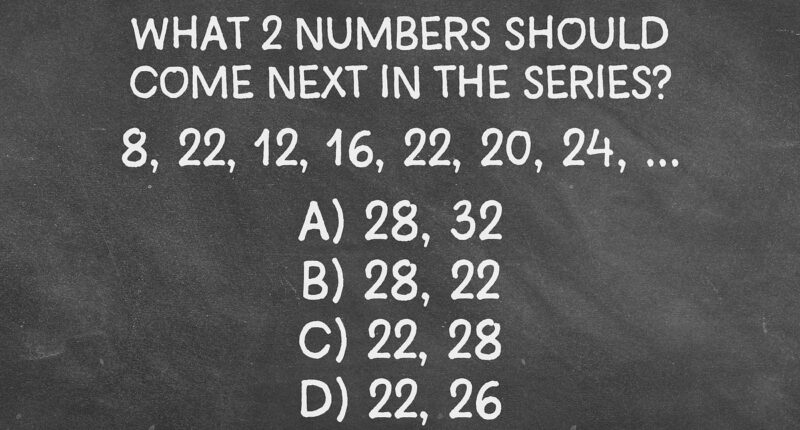A ‘simple’ math sequence has left the internet puzzled, proving that it may be far more complex than it appears at first glance.
The mathematical brain teaser, posted by X user Bholanath DuttaFounder, appears to show a basic numerical sequence, equipped with seven numbers.
At first, the sequence seemingly shows a pattern – one that is not so easily cracked.
The post has left the internet scratching their heads, with brave participants offering conflicting answers in their attempts to solve it.
Will you be the one to crack the code and figure out the next two numbers in the series? Give it a try!
Here’s the sequence: 8, 22, 12, 16, 22, 20, 24, …..
A) 28, 32
B) 28, 22
C) 22, 28
D) 22, 26

The internet is puzzled by a seemingly ‘simple’ math sequence, indicating that it might be more complex than it appears initially, revolving around a basic numerical order.
The first key to solving this mind-bending puzzle is to identify a pattern, specifically, an alternating one.
Have you solved it?
If you managed to solve it, well done! You must be quite the math whiz. If not, here’s a clue: The sequence establishes a pattern of alternating repetitions, utilizing basic addition with a focus on the number four.
The correct answer pointed out by one participant is as follows:
8, 22, (+4), 12, 16, 22, (+4), 20, 24, 22, (+4), 28
Several users were able to successfully identify the correct answer, which is option C: 22, 28.
This sequence switches between a consistent pattern and an ‘unexpected’ number. In this instance, the number 22 pops up every third time, unexpectedly breaking the flow of the regular pattern.
Aside from the 22, the sequence progresses by adding four to each number, creating the next number in the pattern.

In simple terms, the perplexing sequence mostly follows a straightforward ‘add four’ rule, but every third number is replaced with a 22 instead

Seeing connections within a sequence can deepen one’s understanding of all mathematical concepts – building a strong foundation for advanced problems, enhancing problem-solving skills and generating greater success in various fields like finance, science and technology
For example, if the current number is 16, the next one will be 20 (16+4).
The random number of 22 appears every third time in the pattern, breaking the ‘add 4’ sequence.
While the pattern usually adds four, the 22 is inserted at set intervals – or every third time – disrupting the sequence until it starts back up again and making the otherwise simple equation much more challenging.
In simple terms, the perplexing sequence mostly follows a straightforward ‘add four’ rule, but every third number is replaced with a 22 instead.
This puzzle is just the latest in a series of mind-bending problems that have captivated social media users worldwide.
Patterns are a fundamental factor to mathematics, appearing in numbers, shapes, algebraic expressions and the way we solve everyday problems.
Recognizing these patterns can help in predicting future events, a skill that can be applied in the real world to forecast trends.
Identifying a problem can also reduce the complexity of a problem but revealing patterns and relationships between numbers that are not immediately obvious.
Additionally, seeing connections within a sequence can deepen one’s understanding of all mathematical concepts – building a strong foundation for advanced problems, enhancing problem-solving skills and generating greater success in various fields like finance, science and technology.

















